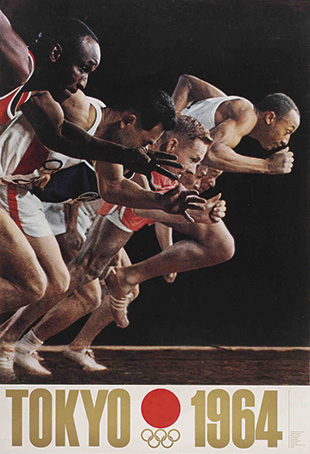
September 27, 2013
The Olympics Are Coming!
Preparing for 2020 by looking back at 1964
By Metropolis
Originally published on metropolis.co.jp on September 2013

It will be hard for the Tokyo 2020 Olympic Games to make the same kind of impact on the city and the country as the last event of its kind, held here 49 years ago. Tokyo 1964 was undoubtedly special. It marked an important watershed in the country’s history and influenced so much, from architecture and infrastructure to the social mood and the international perception of Japan, which, of course, greatly improved.
To coincide with the International Olympic Committee’s decision on the 2020 venue, the Edo-Tokyo Museum bravely decided to host an exhibition entitled “The Olympics Are Coming!” looking at the art, posters, photography and various odds and ends from the 1964 games.
This was a risky strategy, as the exhibition would have looked ridiculous if the IOC had instead chosen Madrid or Istanbul and the Olympics were not coming, but luckily Tokyo triumphed and now, with the world’s eyes upon us, it’s fitting to think what the Olympics will mean through the prism of a previous experience.
The exhibition is divided into several sections that look at the planned 1940 Tokyo Olympics (cancelled due to war), the post-war reconstruction, the preparations for the 1964 Olympics and the actual games themselves.
Coming four years after the 1936 Berlin “Hitler” Olympics, at which the Olympic torch was used for the first time, Tokyo’s 1940 Games was intended to coincide with the 2600th anniversary of the mythical founding of the Japanese imperial house, and was going to be used to boost the cult of the Emperor, but events determined otherwise.
The section on post-war reconstruction presents aerial views of the city, including the Washington Heights housing area in Shibuya. Built as housing for the US Occupation forces, this was later transformed into the Olympic village and then Yoyogi Park, marking a significant stage in Japan’s post-war normalization.
Guide books on manners, architectural diagrams and publicity posters all testify to the enormous efforts that the Japanese people put into preparing for the Games. This naturally also boosted the learning of English. Attempts were also made to beautify the city, but, on the other hand, some of the infrastructure projects connected to the Olympics, such as concrete expressways, had quite the opposite effect.
Special efforts were made concerning the weather, as well. Unusually, the 1964 “Summer Olympics” were actually held in the autumn, quite sensibly in view of Tokyo’s terrible summer heat and humidity. The date chosen for the all-important opening ceremony (October 10) was selected because, statistically, it was the day of the year most likely to be sunny, and therefore a meteorological representation of the national symbol.
The actual items from the 1964 Olympics—the torch used to light the Olympic flame, the vest of the runner who carried it, blazers of the officials, the programs and souvenirs—inevitably have the slightly sad atmosphere of mementos and nostalgia, but there is also a sense of a great epic event of the past, one that united the nation and successfully repackaged it for the boom times that followed.
With the problems caused by the 2011 earthquake and the Fukushima nuclear accident, as well as ongoing criticism of the government’s priorities, it may be difficult for Japan to recapture the sense of naive optimism that preceded the 1964 Olympics, but if it can be done anywhere, it can be done by visiting the Edo-Tokyo Museum.
Edo-Tokyo Museum
The Olympics are Coming! A look back at Tokyo and the 1964 games. Until Oct 10, ¥300-600. Open Tue-Fri & Sun 9:30am-5:30pm, Sat 9:30am-7:30pm, closed Mon & hols. 1-4-1 Yokoami. Nearest stn: Ryogoku. Tel: 03-3626-9974. www.edo-tokyo-museum.or.jp





